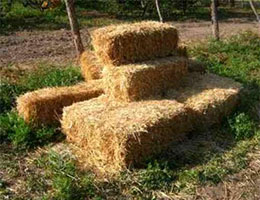 A bundle is called a set of elements that are tied to form a block and thus facilitate its transportation or storage. Bales are usually merchandise that is intended to be transported between different points.
A bundle is called a set of elements that are tied to form a block and thus facilitate its transportation or storage. Bales are usually merchandise that is intended to be transported between different points.
For example: "Please help me arrange the bales of clothes in the warehouse" , "The police discovered several bales of marijuana hidden in the back of the truck" , "The bales of cotton are already prepared for transport" .
Straw bales , also called straw bales and straw bales , are pressed blocks that are used to preserve the food that animals eat in the field . Initially, the bales used to be prism-shaped, although today cylindrical bales are preferred as they can be handled with machinery.
Various crops that are intended for forage can be cut and processed so that, when dried, bales can be formed. Generally each bale of straw weighs about eighteen kilograms.
In many cases, it is not easy to make a bale of satisfactory quality, especially if we do it at an unfavorable time of year. If we must prepare it in spring, for example, weather factors can affect the quality considerably. When reserving forage it is assumed that the material will change from the day it is collected to the moment it is used, and that is why it is so important to choose the best crop possible.
In addition to the quality of the material, it is necessary to collect it at the appropriate time according to the species and to have decided which animals we will give the bale to. On the other hand, we must also pay attention to the phases that follow cutting, that is, wrapping, storage and, finally, the supply itself, to minimize the chances of quality loss.
Cutting grass at the ideal time is not easy, since it partly depends on the type of crop. For example, in the case of ryegrass, oats or barley , the vegetative state directly influences the dry matter yield (that is, the quality and quantity that can be harvested) and this determines the best time to cut them. With the passage of time, the plant becomes more mature and this has a positive impact on the dry matter yield, although negatively on the percentage of protein it contains.
 In the case of grasslands, the best time to cut coincides with the flowering of grasses and legumes. Alfalfa, on the other hand, is a brilliant alternative given its nutritional qualities and forage quality; Regarding the time at which it is recommended to cut it, experts indicate that it is between the beginning and the middle of the flowering process, when considerable volumes of dry matter can be obtained without losing quality.
In the case of grasslands, the best time to cut coincides with the flowering of grasses and legumes. Alfalfa, on the other hand, is a brilliant alternative given its nutritional qualities and forage quality; Regarding the time at which it is recommended to cut it, experts indicate that it is between the beginning and the middle of the flowering process, when considerable volumes of dry matter can be obtained without losing quality.
To know if the cut material has the right degree of humidity to be baled, some experts scratch the stems: if the epidermis of the plant comes off, then it is not ready yet.
In the colloquial language of some regions, we usually speak of burden with reference to a heavy load that a person delegates to another so as not to take charge of it: "My partner went on vacation and left the burden to me," "The "The former president inaugurated a project that is not working and passed the burden to the current president," "Tell the owner of the company to take charge and not try to throw the burden on others."
"El fardo" , finally, is the title of a story written by the Nicaraguan author Rubén Darío that is part of his book "Azul" , published in 1888 .
